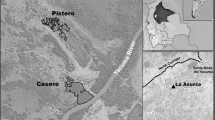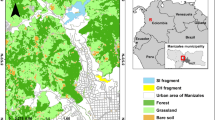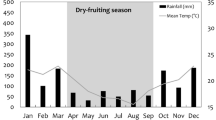Summary
A decline in the density of trees and the deterioration of the habitat of vervet monkeys (Cercopithecus aethiops) in Amboseli National Park, Kenya, have been accompanied by movement of vervet groups into unfamiliar areas. These home range shifts were documented over a period of 26 months. The largest group moved into the home ranges of neighboring groups and acquired more trees, a resource that had become more limited. The groups whose home ranges were encroached upon did not share their home ranges with the intruders, but instead moved into areas that were unoccupied and had a lower density of trees. The largest group was thus more successful than smaller groups in competition for limited resources. For all but one group, movement into new areas was directly associated with the disappearances of female and immature monkeys. Most of the disappearances were attributable to predation. These results suggest that the cost of predation in unfamiliar areas may contribute to the evolution of philopatry in vervets. However, under unstable conditions, resource competition forces these animals to disperse (in groups) despite the high risk of predation.
Similar content being viewed by others
References
Altmann J (1974) Observational study of behavior: sampling methods. Behaviour 49:227–265
Ambrose HW (1972) Effect of habitat familiarity and toe-clipping on rate of owl predation in Microtis pennsylvanicus. J Mammal 53:909–912
Andelman SJ (1985) Ecology and reproductive strategies of vervet monkeys (Cercopithecus aethiops) in Amboseli National Park, Kenya. PhD thesis, University of Washington, Seattle
Cheney DL (1981) Inter-group encounters among free-ranging vervet monkeys. Folia primatol 35:124–146
Cheney DL (1987) Interactions and relationships between groups. In: Smuts BB, Cheney DL, Seyfarth RM, Wrangham RW, Struhsaker TT (eds) Primate societies. University of Chicago Press, Chicago, pp 267–281
Cheney DL, Seyfarth RM (1987) The influence of intergroup competition on the survival and reproduction of female vervet monkeys. Behav Ecol Sociobiol 21:375–386
Cheney DL, Seyfarth RM, Andelman SJ, Lee PC (1988) Reproductive success in vervet monkeys. In: Clutton-Brock TH (ed) Reproductive success. University of Chicago Press, Chicago, pp 384–402
Chepko-Sade BD, Sade DS (1979) Patterns of group splitting within matrilineal kinship groups: a study of social group structure in Macaca mulatta (Cercopithecine: Primates). Behav Ecol Sociobiol 5: 67–87
Clutton-Brock TH, Harvey PH (1977) Primate ecology and social organization. J Zool Lond 183:1–39
Cords M, Rowell TE (1986) Group fission in blue monkeys of the Kakamega Forest, Kenya. Folia primatol 46:70–82
Dunford C (1977) Behavioral limitations of round-tailed ground squirrel density. Ecology 58:1254–1268
Furuya Y (1968) On the fission of troops of Japanese monkeys: I. five fissions and social changes between 1955 and 1966 in the Gagyusan troop. Primates 9:323–349
Hauser MD (1987) Behavioral ecology of free-ranging vervet monkeys: proximate and ultimate levels of explanation. PhD Thesis, University of California, Los Angeles
Hauser MD, Cheney DL, Seyfarth RM (1986) Group extinction and fusion in free-ranging vervet monkeys. Am J Primatol 11:63–77
Healey MC (1967) Aggression and self-regulation of population size in deermice. Ecology 48:377–392
Isbell LA (1990) Sudden short-term increase in mortality of vervet monkeys (Cercopithecus aethiops) due to leopard predation in Amboseli National Park, Kenya. Am J Primatol 21:41–52
Koyama N (1970) Changes in dominance rank and division of a wild Japanese monkey troop in Arashiyama. Primates 11:335–390
Krebs JR (1971) Territory and breeding density in the great tit Parus major L. Ecology 52:22–52
Kruuk H (1986) Interactions between Felidae and their prey species: a review. In Miller SD, Everett DD (eds) Cats of the world: biology, conservation, and management (Proc. 2. Int. Symp., 1982), National Wildlife Federation, Washington, DC, pp 353–374
Lee PC (1981) Ecological and social influences on the development of vervet monkeys. PhD Thesis, Cambridge University, Cambridge
Metzgar L (1967) An experimental comparison of screech owl predation on resident and transient white-footed mice (Peromyscus leucopus). J Mammal 48:387–391
Myers JP, Connors PG, Pitelka FA (1979) Territory size in wintering sanderlings: the effects of prey abundance and intruder density. Auk 96:551–561
Myers K, Hale CS, Mykytowycz R, Hughes RL (1971) The effects of varying density and space on sociality and health in animals. In: Esser AH (ed) Behavior and environment: the use of space by animals and men. Plenum Press, New York, pp 148–187
Nash LT (1976) Troop fission in free-ranging baboons in the Gombe Stream National Park, Tanzania. Am J Phys Anthropol 44:63–78
Norton-Griffiths M (1979) The influence of grazing, browsing, and fire on the vegetation dynamics of the Serengeti. In: Sinclair ARE, Norton-Griffiths M (eds) Serengeti: dynamics of an ecosystem. University of Chicago Press, Chicago, pp 310–352
Pusey AE, Packer C (1987) Dispersal and philopatry. In: Smuts BB, Cheney DL, Seyfarth RM, Wrangham RW, Struhsaker TT (eds) Primate societies. University of Chicago Press, Chicago, pp 250–266
Schaik CP van, Noordwijk MA van (1988) Scramble and contest in feeding competition among female long-tailed macaques (Macaca fascicularis). Behaviour 105:77–98
Seyfarth RM, Cheney DL (1980) The ontogeny of vervet monkey alarm calling behavior: a prelimininary report. Z Tierpsychol 54:37–56
Siegel S (1956) Nonparametric statistics for the behavioral sciences. McGraw-Hill, New York
Stenger Weedon J (1965) Territorial behavior of the tree sparrow. Condor 67:193–209
Struhsaker TT (1967) Ecology of vervet monkeys (Cercopithecus aethiops) in the Masai-Amboseli Game Reserve, Kenya. Ecology 48:891–904
Struhsaker TT (1973) A recensus of vervet monkeys in the Masai-Amboseli Game Reserve, Kenya. Ecology 54:930–932
Struhsaker TT (1976) A further decline in numbers of Amboseli vervet monkeys. Biotropica 8:211–214
Struhsaker TT, Leland L (1988) Group fission in redtail monkeys (Cercopithecus ascanius) in the Kibale Forest, Uganda. In: Gautier-Hion A, Bourliere F, Gautier J-P, Kingdon J (eds). A primate radiation: evolutionary biology of the African guenons. Cambridge University Press, Cambridge, pp 364–388
Sugiyama Y (1960) On the division of a natural troop of Japanese monkeys at Takasakiyama. Primates 2:109–148
Trivers RL (1972) Parental investment and sexual selection. In: Campbell B (ed) Sexual selection and the descent of man, 1871–1971. Aldine, Chicago, pp 136–179
Van Vuren D (1990) Dispersal of yellow-bellied marmots. PhD Thesis, University of Kansas, Lawrence
Walker BH, Noy-Meir I (1982) Aspects of stability and resilience of savanna ecosystems. In: Huntley BJ, Walker BH (eds) Ecology of tropical savannas. Ecological Studies, vol 42, Springer-Verlag, New York, pp 556–590
Waser PM, Jones WT (1983) Natal philopatry among solitary mammals. Quart Rev Biol 58:355–390
Western D (1983) A wildlife guide and a natural history of Amboseli. General Printers, Nairobi
Western D, Praet C van (1973) Cyclical changes in the habitat and climate of an East African ecosystem. Nature 241:104–106
Wolfheim JH (1983) Primates of the world: distribution, abundance, and conservation. University of Washington Press, Seattle
Wrangham RW (1980) An ecological model of female-bonded primate groups. Behaviour 75:262–300
Young TP, Lindsay WK (1988) Role of even-age population structure in the disappearance of Acacia xanthophloea woodlands. Afr J Ecol 26:69–72
Author information
Authors and Affiliations
Additional information
Offprint requests to: L.A. Isbell
Rights and permissions
About this article
Cite this article
Isbell, L.A., Cheney, D.L. & Seyfarth, R.M. Costs and benefits of home range shifts among vervet monkeys (Cercopithecus aethiops) in Amboseli National Park, Kenya. Behav Ecol Sociobiol 27, 351–358 (1990). https://doi.org/10.1007/BF00164006
Received:
Accepted:
Issue Date:
DOI: https://doi.org/10.1007/BF00164006




